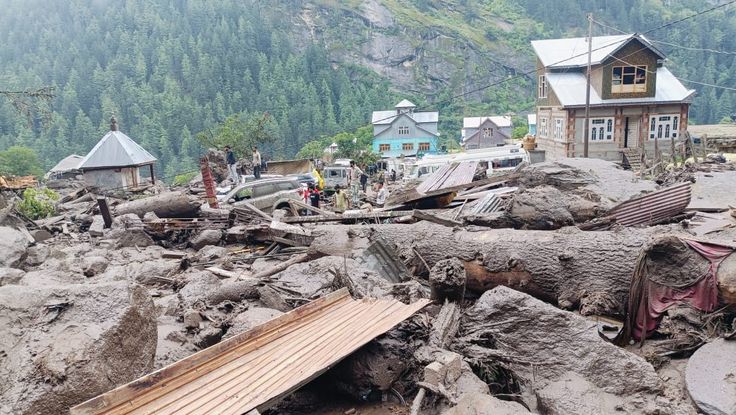A night of devotion turned into disaster when a sudden cloudburst near Vaishno Devi triggered landslides and flash floods, sweeping away pilgrims on the sacred track. In minutes, chants of prayer gave way to cries of fear, leaving 13 dead, scores injured, and thousands stranded in Jammu & Kashmir.
Jammu & Kashmir, August 27, 2025: Tragedy struck the revered pilgrimage route to the Vaishno Devi shrine late Tuesday night when a sudden cloudburst triggered flash floods and a massive landslip, claiming the lives of at least 13 people and leaving dozens injured. The incident occurred near Himkoti on the Vaishno Devi track, where thousands of devotees were making their way to the holy cave shrine in Katra, Reasi district.
According to officials from the Jammu and Kashmir Disaster Management Authority, the cloudburst occurred around 11:45 p.m. following several hours of heavy rainfall in the Trikuta hills, where the Vaishno Devi shrine is located. The downpour quickly turned into a deluge, with torrents of water gushing down the slopes, carrying debris, boulders, and mud along the pilgrim track.
Several pilgrims were caught unawares as the sudden landslip buried parts of the pathway near Himkoti. Rescue workers later confirmed that 13 devotees lost their lives, including three women and two children. Over 30 others sustained injuries ranging from fractures to head wounds and were immediately shifted to hospitals in Katra and Jammu.
Eyewitnesses described a scene of chaos and panic. “We were walking in a group when suddenly water and rocks came rushing down. People screamed and tried to run, but in the darkness and rain, many slipped and got trapped,” said Ramesh Sharma, a pilgrim from Punjab who narrowly escaped.
Rescue Operations in Full Swing
The NDRF, SDRF, police, and Army rescue teams were promptly activated by the administration. Despite the torrential rain and the sloping terrain, teams fought through the night to recover survivors and recover the dead from the wreckage.
At dawn, the Indian Air Force launched helicopters and deployed a C-130J Super Hercules aircraft, carrying relief material, medical supplies, and additional rescue personnel to Jammu airbase. From there, material was airlifted to Katra for distribution to stranded pilgrims.
District officials confirmed that thousands of devotees were escorted to safer zones. Drone surveillance and sniffer dogs were used to trace missing persons as heavy machinery cleared blocked pathways.
Vaishno Devi Shrine Board’s Response
The Shri Mata Vaishno Devi Shrine Board, which manages the pilgrimage, suspended yatras temporarily from the affected route and diverted devotees through alternative tracks. Special shelters and food distribution centers were opened for stranded pilgrims at Adhkuwari and Sanjichhat.
Shrine Board CEO Anshul Garg expressed condolences, saying, “This is an unprecedented natural calamity. We are doing everything possible to support the affected families. Free medical aid, accommodation, and compensation packages are being arranged immediately.”
Government Response
Omar Abdullah, the chief minister of Jammu & Kashmir, traveled to Katra to supervise rescue operations. With sorrow, he said:
“This is an unimaginable tragedy. My heart goes out to the families who lost their loved ones. The government is dedicated to providing restoration and relief as soon as possible. Strict instructions have been issued to provide every possible assistance to survivors and stranded pilgrims.”
He also announced ₹10 lakh compensation for the deceased and ₹50,000 for the injured, alongside long-term measures to strengthen disaster preparedness on pilgrimage routes.
At the national level, Prime Minister Narendra Modi expressed sorrow over the tragedy, assuring full central support for rescue and relief. Union Home Minister Amit Shah commended the Air Force, Army, and NDRF for their “swift and coordinated” reaction.
Climate Change and Rising Cloudburst Risks
Meteorologists explained that cloudbursts — sudden, intense rainfall in localized areas — are becoming more common in Jammu and Kashmir due to climate change.
Dr. Rajendra Tiwari, a climatologist, said: “With global warming, the atmosphere holds more moisture. When it releases suddenly over hilly terrain, it causes devastating cloudbursts and flash floods. This is not the last such event we will see.”
The region has already witnessed similar disasters in Leh (2010), Amarnath (2022), and Kishtwar (2021). Experts are urging the government to install real-time weather monitoring systems, early-warning networks, and climate-resilient infrastructure in pilgrimage areas.
Trains and Highway Shut
The cloudburst’s effects were felt far beyond the shrine. The Jammu-Srinagar National Highway had to be closed due to landslides brought on by the continuous rain. Thousands of people were left stranded at stations after railway officials suspended several trains that were headed for Jammu and Katra.
Authorities set up emergency counters to help passengers rebook tickets or arrange alternative accommodation. Long queues of vehicles lined the highway as clearance teams worked to remove boulders and restore connectivity.
Calls for Better Preparedness
The incident sparked fresh debate about managing religious tourism in ecologically fragile zones. Environmentalists warned that overcrowding, deforestation, and haphazard construction along the Vaishno Devi route increase vulnerability.
“The Trikuta hills are not meant to bear unchecked development. Authorities must restrict footfall during adverse weather and create disaster shelters at regular intervals,” said activist Sunita Kaul.
Relief and Rehabilitation
By Wednesday evening, all 13 victims were identified and their bodies handed over to families. The administration set up help desks at Jammu, Katra, and New Delhi railway stations for families of missing persons.
The Air Force continued air-dropping relief material, while engineers worked round-the-clock to restore damaged pathways. Local residents of Reasi opened their homes and kitchens to stranded pilgrims, demonstrating resilience and compassion.
The Vaishno Devi cloudburst disaster has left behind grief and urgent lessons. With 13 lives lost, yatras suspended, highways and trains disrupted, and relief operations still underway, the tragedy underscores both the unpredictability of nature and the fragility of human preparedness.
Yet amid the sorrow, the swift response of rescue forces, the solidarity of locals, and the unwavering faith of devotees shine through. Even though many people’s journeys have been halted, their devotion to Mata Vaishno Devi has not changed.
Related News: Read More




Pingback: Minneapolis School Tragedy: Two Children Dead, Seventeen..